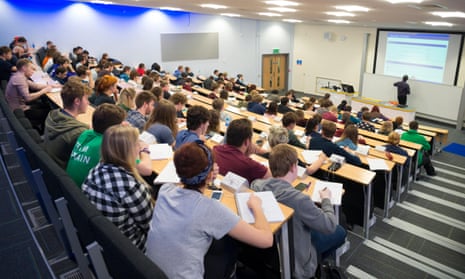Tony Blair’s pledge that half of all young people should go on to higher education is within a whisker of becoming true as official figures revealed that 49% of those in England are expected to have entered advanced studies by the age of 30.
The government’s measure of higher education participation has reached its highest level since the introduction of £9,000 tuition fees in 2012, equalling the previous record of 49% since the annual estimates were first produced in 2006.
The figures show that the participation rate rose by 1.4 percentage points last year, thanks to a 10,000 rise in the number of those aged 17-30 going to university for the first time in 2015-16, including full-time and part-time learners.
The participation rate among people entering higher education immediately after leaving school also reached a record level last year, with more than 27% of all 18-year-olds going into higher education and growing at a faster rate than the increase in the population.
Blair pledged – in a speech as prime minister to the Labour party conference in 1999 – that 50% of all young people should take part in higher education, although his expected deadline of 2010 has been missed.
Jo Johnson, the universities minister, said the figures were good news and evidence that the government’s efforts to widen participation were working.
“Young people recognise that degrees gained from UK universities can lead to rewarding and well-paid jobs – this is why more people are going to university than ever before, including record numbers of 18-year-olds from disadvantaged backgrounds,” he said.
“We continue to improve the university system to ensure that students get value for money and are creating a new regulator, the Office for Students, to hold universities to account for teaching quality and student outcomes through the teaching excellence framework.”
Alistair Jarvis, the chief executive of Universities UK, said the figures showed that demand for university education remained strong, with students recognising the advantages it brought.
“There is increasing demand from UK industry and the public sector for graduate skills. Our universities are training future teachers, doctors, engineers, entrepreneurs that our society and economy needs,” he said.
However, Jarvis warned that there remained a “worrying” decline in part-time and mature student numbers. “It’s important that government and universities work together to consider how we can better encourage and support part-time and mature learners.”
The data also showed that the gender gap appears to have become further entrenched, with 55% of women estimated to go to university – a rise of 2.3 percentage points in the space of a year – compared with 43% of men, a gap of 12 percentage points.
The figures include all English-based students aged 17 to 30, studying on courses lasting at least six months, and those on advanced courses at further education colleges in England, Scotland and Wales as well as other higher education providers.
But the totals do not include alternative providers other than the private University of Buckingham.
